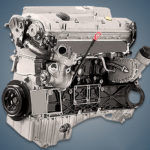The in-line 6-cylinder Mercedes M103 E30 engine was introduced in 1985 and was intended to replace the outdated M110 engine and was partially unified with the 4-cylinder M102.
The R6-family includes: M103 E26, M103 E30, M104 E28, M104 E30, M104 E32, M256 E30.
The 103 series received a new lightweight cast iron cylinder block and a 12-valve block head with a single camshaft and hydraulic lifters, instead of the previous 24-valve twin-shaft, which was caused by a desire to increase efficiency, reduce the weight of the power plant and reduce the cost of its production. The diameter of the intake valves is 43 mm, exhaust 39 mm. Fuel injection system – mechanical injection. The timing drive uses a not very reliable single-row chain. Fuel supply system – KE-Jetronic.
Specifications
| Production years | 1985-1993 |
| Displacement, cc | 2960 |
| Fuel system | KE-Jetronic |
| Power output, hp | 180 – 190 |
| Torque output, Nm | 255 – 260 |
| Cylinder block | cast iron R6 |
| Block head | aluminum 12v |
| Cylinder bore, mm | 88.5 |
| Piston stroke, mm | 80.2 |
| Compression ratio | 9.2 – 10.0 |
| Features | no |
| Hydraulic lifters | yes |
| Timing drive | chain |
| Phase regulator | no |
| Turbocharging | no |
| Recommended engine oil | 5W-40 |
| Engine oil capacity, liter | 6.0 |
| Fuel type | petrol |
| Euro standards | EURO 0/1 |
| Fuel consumption, L/100 km (for 300 SL R107) — city — highway — combined |
16.0 10.5 14.5 |
| Engine lifespan, km | ~450 000 |
Disadvantages of the M103 E30 engine
- Most often, car owners with such a power unit are faced with lubricant leaks.
- The weak points for leaks here are the U-shaped gasket and the crankshaft oil seal.
- The second most common problem is engine failure due to clogged injectors.
- The reason for the oil burner is usually in the valve stem seals and it goes away after they are replaced.
- After 150,000 km, a single-row timing chain may already stretch and require replacement.





